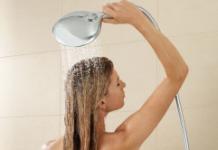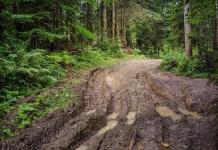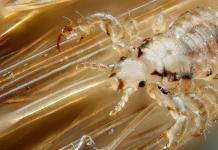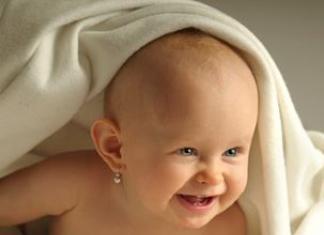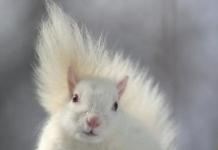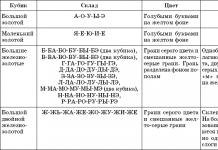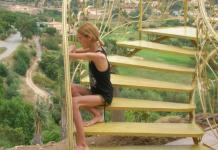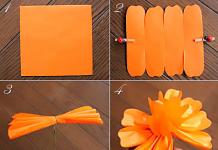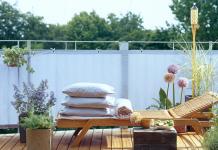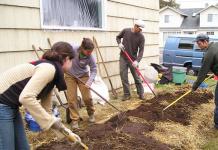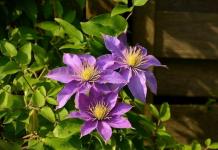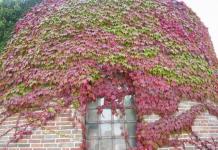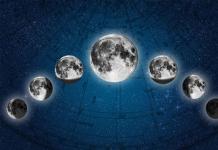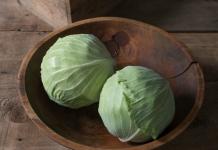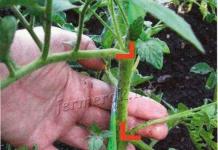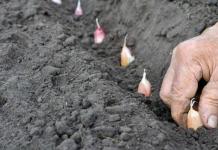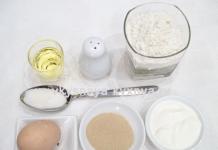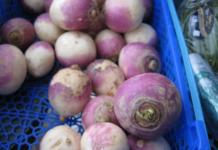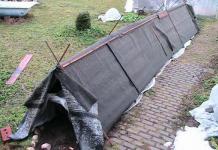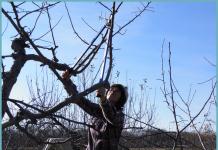Which aquarium plants are better - live or artificial?
Aquarium plants play very important role when arranging an aquarium. It is the plants that set the tone and appearance of the entire aquarium, so their choice must be approached very carefully and responsibly. All plants can be divided into two large groups:
Artificial;
It is advisable to think about what kind of plants will be in your aquarium even before you start the fish. This is due to the fact that living plants require special soil and proper lighting. In addition, some fish like to arrange rearrangements in the aquarium - transfer the soil, pull everything to the surface, so for such fish the plants must be large enough and heavy or floating, which can move freely around the aquarium.
So which plants are best? To answer this question, you need to consider the advantages and disadvantages of each type of plant and then draw the appropriate conclusions.
Natural (live) plants give the aquarium a more natural and natural look, and they also help the fish adapt to life in the aquarium because they more closely resemble the fish's natural habitat. Living plants require careful selection of soil and proper planting, so it is very important to decide on the choice of plants before starting the aquarium. This is necessary in order to carefully select a suitable soil and form the desired system feeding plants so that they can fully live and grow in the aquarium. Many people think that living plants require a lot of attention, but in reality, this is not the case. Increased attention is required only when planting these plants, and further caring for them will take a little time. All care for living plants can be roughly divided into several stages:
1. and correct planting of plants. Before planting, the roots of the plants are slightly cut, and after that they are immediately planted in the ground. The recommended soil thickness is at least 5 cm, in addition, its composition must be varied and correct. In order for the plant to quickly take root and begin to grow, you can use special ones that are placed in the hole where the plant will be planted. These pills can be purchased at any pet store that sells live plants.
2. Lighting plays an important role in the life of plants, in total for full development it is necessary that the daylight hours in the aquarium lasts 12 hours, but such an amount of light can negatively affect the fish themselves, therefore many aquarists recommend making daylight hours within 6-9 hours. This time is quite enough to give the plants the necessary amount of light without harming the fish.
3. Grooming and removing excess daughters is a regular procedure that needs to be done about once every five weeks. This procedure is similar to the one that needs to be carried out with ordinary indoor flowers. Use scissors to remove yellowed and old leaves that can spoil the look and clog the aquarium. Some aquarium plants grow very quickly, so they need to be planted and excess plantings removed.
4. Periodic feeding of plants is a prerequisite for plantings to grow normally and not die. It is best to use special preparations for feeding. Now on the shelves of pet stores there is a fairly wide range of various vitamin complexes for plant nutrition. When choosing, it is better to give priority to professional firms that will definitely not harm.
The first two points are one-time - the soil, planting and will take a lot of time only when you start the aquarium, and all further care is in points 3 and 4. It turns out that in general, caring for living plants is not so difficult and even a beginner can handle it. Of course, much still depends on the type of plant itself, there are some specimens that require special lighting, water hardness, soil quality, etc. These types of plants are not recommended for beginners - it is difficult for them to create the necessary conditions, and without this they will start to get sick and even die. For a beginner, ordinary plants are best suited, which do not require additional maintenance and are easy to take root.
Unpretentious aquarium plants are divided into several types:
1. Floating on the surface. These plants do not require planting, they float on the surface of the water and can even cover the entire surface of the water, but this is not recommended, since then the light will not be able to enter the water and the bottom of the aquarium will be dark all the time. The easiest floating plants to care for:
Salvinia.
2. Plants floating in water are unique in their own way - they do not need special soil and they easily take root under normal conditions. Such plants usually have a poorly developed root system or it is absent altogether, but the deciduous part is well developed, which makes these plants especially popular among beginners. These plants can simply float in the water and move along with streams of water, which are aerated or attached to various decorative elements of the aquarium. If they are attached, they take on the appearance of a plant that grows from the ground, many like this option much more. Most often, plants are attached to snags and various locks. For fastening, it is best to use a thread, which you can simply tie the plant, it is undesirable to use various weights or press down with soil - this can damage and spoil the plant itself. The most common types:
Cladophorus;
Ludwigia;
Shytolistnik (various types);
Vesicularia (Javanese moss);
Nitella;
Ferns.
3. Soil plants - the most demanding of the considered species, they need a soil that will help them grow normally and strengthen their roots. The soil must be at least 5 cm thick. It should contain peat and clay, and in size it should not be very small, but not very large. Such plants grow thanks to their root system, which in turn develops thanks to the quality of the soil. If dots or spots begin to appear on the leaves of such plants, then the soil is depleted and the plant does not receive the necessary nutrients. For such plants, the soil must be periodically supplied with nutrients so that the plants can get everything they need. The most common types:
Vallisneria;
Cryptocoryne;
Echinodorus:
Ammania;
Anubias.
The advantages of living plants are much greater than the disadvantages, we will consider them in more detail.
Advantages:
The main plus of living plants is their ability to release oxygen and absorb carbon dioxide, which is released in connection with the life of fish. With the correct formation of the number of fish and plants, an ideal balance can be achieved when the fish have enough oxygen, which the plants emit. In this case, there is no need to install mechanical aerators, which in turn has many advantages. A mechanical aerator takes up space in the aquarium, spoils its appearance and naturalness, in addition, it always makes noise, which is also not very pleasant;
Plants are the biological filter of the aquarium - they absorb harmful and hazardous substances that form in the aquarium;
Many fish use plants for shelter, in addition, fish can make nests in living plants. In such plantations, fry live and grow, which cannot survive in open space;
Living vegetation is a natural and safe food for many fish. Many fish happily nibble fresh leaves instead of dry food, so plants can serve them not only as a shelter, but also as food;
Living plantations inhibit the growth and development of algae;
Aesthetic appearance. If a person decides to equip an aquarium at home, it means that he is going to make it his hobby, and growing greenery, new leaves and a beautiful appearance will always delight the owner of the aquarium.
In addition to the considered advantages, living plants have several disadvantages:
Care, even the simplest living plants require care and time;
With improper or insufficient care, the plants begin to hurt, which noticeably worsens the appearance of the aquarium, in addition, live plants are very difficult to treat;
Plants can grow strongly, sometimes their number reaches such a critical level when there is little space for the fish;
Many fish like to pinch plants, which also impairs their appearance;
If large fish live in the aquarium that like to dig in the soil, then any soil plant will be damaged and may even die.
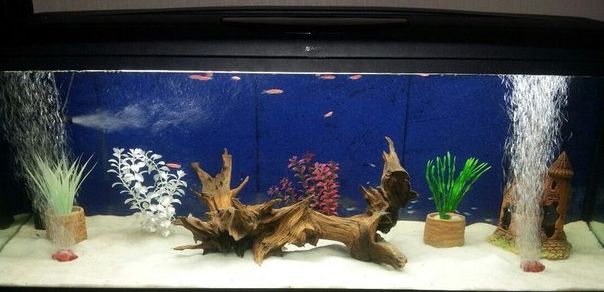
Recently, they have become more and more popular. This is due to two factors - ease of care and an exact copy of live analogues. Previously, artificial plants had the most incredible shapes and colors, which was completely inappropriate to use to create the most natural conditions in the aquarium. But recently, many artificial plants have begun to appear, which outwardly are very similar to living ones. Artificial options can have different heights, which will allow you to equip even the tallest aquarium, and a bright and rich color will always delight the eye.
Advantages:
The obvious and main advantage is ease of maintenance. You just need to rinse the plastic and put it in the right place. This completes the care of the artificial plant. All artificial plants have a special weight that can be placed on the bottom of the aquarium and, if desired, covered with any soil;
Artificial plants do not get sick or deteriorate;
If desired, they can be easily changed to new plants or simply rearranged to another place;
Fish will not spoil such plants, since they are completely inedible;
Great for beginners who cannot spend a lot of time caring for plants;
They can be washed with every water change, along with other decorative elements.
The disadvantages of artificial plants include:
They cannot fully replace living plants, since they do not participate in photosynthesis and do not emit oxygen;
Some artificial plants can release harmful substances that can negatively affect the fish;
Artificial plants do not inhibit the growth of harmful bacteria and lower types of algae, which can lead to blooming of the water and the walls of the aquarium.
So, having considered all the pros and cons of living and artificial plants, you can try to answer the main question - which is better. Despite the ease of caring for artificial plants, live planting clearly has more benefits. Even a beginner will be able to choose simple types of plants for themselves that will not require careful maintenance and at the same time will become an indispensable element of decor. By the way, many professional aquarists combine live and artificial plants in large aquariums to combine the benefits of both types of plants. What to choose in a particular case depends on the desire of the person, if the aquarium is settled at home, and the future owner wants to have not only a beautiful and natural, but also a unique appearance, then living plants will help him with this. If little time will be devoted to caring for the aquarium, or if a person does not want to engage in the selection and care of living vegetation, then it is better to buy several options for artificial plants.
Algae grows in aquariums, salt water and fresh water, which means that the aquarium is alive. Friends who are beginners believe that algae are plants that live in an aquarium. However, it is the aquarium plants that live, in the algae these are unwanted and unloved guests, as they only spoil the appearance of the aquarium. Let's just say that algae growth for the aquarist is just a sign that something is wrong in the aquarium.
All aquariums contain algae, on sand and gravel, rocks and plants, walls and equipment. They are quite natural and are part of the normal balance, if they do not grow rapidly. All that is required of a balanced aquarium is clear, well-mixed water and clean glasses. I even advise not to clean all the walls of the aquarium, leaving the back covered with fouling. I have noticed that when algae is left to grow on the back wall or on rocks, it absorbs nitrates and other debris, thereby reducing the potential for algae to grow on the front and side walls of the aquarium. Also on overgrown glass, some species of fish will feed on algae and microorganisms, such as all types of chain mail catfish.
How to get rid of algae in your aquarium?
For example, algae of the genus Aufwuchs (from German for growing on something) grow on hard substrates such as rocks in both fresh and salt water. Algae, especially green and diatoms, are the primary habitat for small crustaceans, rotifers, and protozoa. Many aquarium inhabitants feed intensively on algae-overgrown surfaces. The cichlids of Lake Malawi are widely known as fish that have adapted to feeding on algae. Examples of the type, Labeotropheus trewavasae and Pseudotropheus zebra, are very characteristic. They have hard teeth that allow algae to be lifted off the rocks. Mollies look for algae clearings and pluck them. In the marine environment, algae are an important part of the diet. sea urchins, sea worms and chitons.
I stimulated algae growth in my cichlid to create a natural environment, and got the right amount of filamentous and diatoms. Thus, depending on the species of fish and biotope from the habitat, growing algae may even be desirable. Algae are an essential part of the diet of species such as mollies, African cichlids, some Australian fish and catfish type or otocyclus. Frequent water changes reduce the amount of nitrate in the water and reduce algae growth. In a well-balanced aquarium, abundantly overgrown with plants, the balance of minerals is in balance, the surplus is consumed by plants and algae. And since higher plants always consume more nutrients than algae, their growth is limited.
Green algae in the aquarium or xenococus
Found in most aquariums as green dots or green sheeting. These algae love a lot of light. Green algae only grow if the amount of light and nitrate exceeds the level that higher plants can absorb. In densely planted aquariums, green algae develop extremely poorly, as higher plants consume nutrients, and absorb the light necessary for the vigorous growth of green algae. Without condemning the use of plastic plants in an aquarium, I will note that living plants look the best and create conditions for the normal development of the entire biosystem.
However, they can grow en masse in aquariums with CO2 systems, due to fluctuations in the level carbon dioxide during the day. An outbreak of green algae growth can occur suddenly, especially when the level of phosphate and nitrate in the water is high. They usually appear as green dots covering the glass surface and the bottom of the aquarium. Recommended remedies are to reduce the amount of light and the length of daylight hours, and mechanical cleaning - with special brushes or a blade.
Mollies and catfish, for example, eat green algae very well, and I keep a few specially for this purpose. It also copes well with xenocokus and other algae. 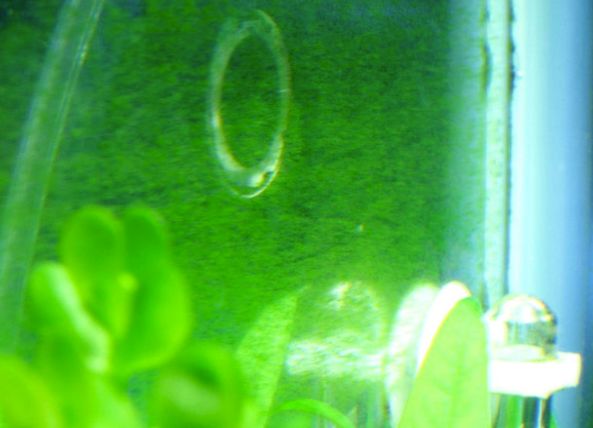
Black beard
The appearance of a black beard in the aquarium is a sign that the amount of waste has increased greatly, because organic residues serve as food for it. It is these algae that most often grow on the walls of the aquarium and the plants in the aquarium, in the form of a thick and disgusting black carpet. How to deal with a black beard? The main method of struggle is to reduce the level of organic matter. Soil cleaning, water changes and filtration seriously slow down and reduce the growth of black beard. To do this, you need to remove organic residues from the soil - slightly siphon the surface of the soil. Also, a black beard likes to settle in places with a good flow, these are filter tubes, filter surfaces, etc. The current gives the beard abundant nutrition, organic matter settles on its surface. It is recommended to reduce strong currents in the aquarium. To reduce the amount of nutrients in the water, in addition to harvesting, you can have various fast-growing plant species - elodea, nayas.
How to deal with a black beard in an aquarium? Recently, a new remedy for combating beard and flip-flops has appeared - Cidex. It was originally used (and is used) in medicine, for disinfection. Who came up with the idea of using sidex against a black beard, apparently, will remain unknown. But the fact is that sidex works against both black beard and flip flops.
Sidex is poured once a day, in the morning. The initial dose is 10-15 milliliters per 100 liters of water. Gradually, you can increase to 25-30 milliliters (be careful, at 30 ml Platidoras died!). A Vietnamese woman begins to die already at 15-20 milliliters. They write that it does not completely kill a Vietnamese woman, but this is not so. You just need to add sidex for another two weeks after the flip-flop disappears completely. There is an experience of complete cleansing of aquariums from it. At small doses (up to 20 ml), no negative effect on fish was noticed, however, some plants - hornwort, Wallinsneria, Cryptocoryne, Sidex do not like and may die. In any case, this mention of the drug is for informational purposes only, be sure to read the profile forums before use. This drug is not safe! 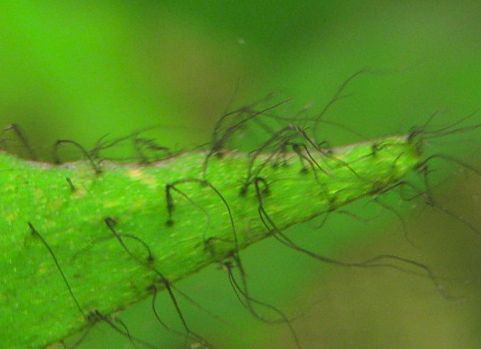
Brown algae in the aquarium
Brown algae grows quickly if there is too little light in the aquarium. They look like brown patches covering everything in the aquarium. Usually, light-loving plants are in poor condition or disappear. Plants that tolerate shading well, such as Javanese moss, dwarf anubias and other types of anubias, can be covered with a brown film, and the tough leaves of anubias can be rubbed to get rid of brown algae. Again, aquarium cleaners, ancistrus, or otsinkluses are helpful. But the simplest solution is to increase the intensity and duration of daylight hours. Usually, brown algae will quickly disappear, as soon as the lighting is in order.
Brown algae very often form in young aquariums with unstable balance (younger than ~ 3 months), with the wrong lamp spectrum and with too long daylight hours. An even greater increase in daylight hours can lead to even worse consequences. 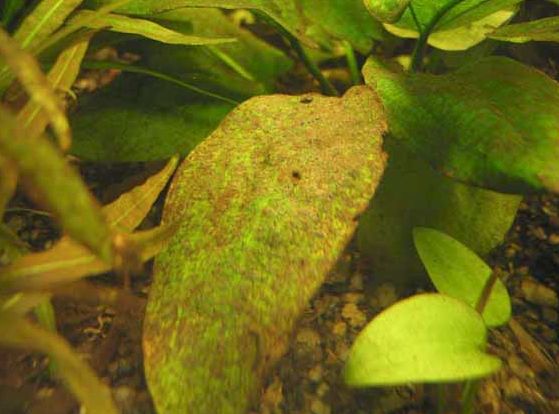
Flip flop in the aquarium
Frequent visitor to new aquariums with an unsettled nitrogen cycle. By nature, it is close to a black beard and therefore the methods of dealing with it are similar. Reducing nitrate levels by cleaning the soil, replacing water and filtering with a powerful filter.
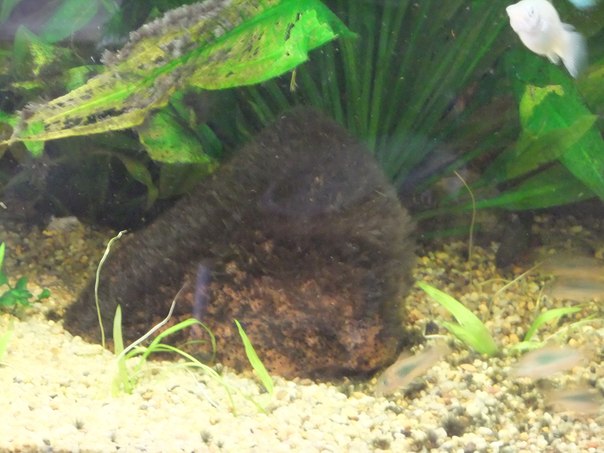
Vietnamese in all its glory
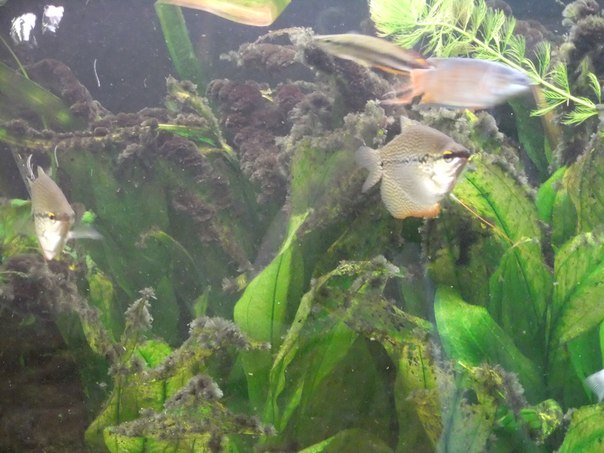
This is how the Vietnamese grows
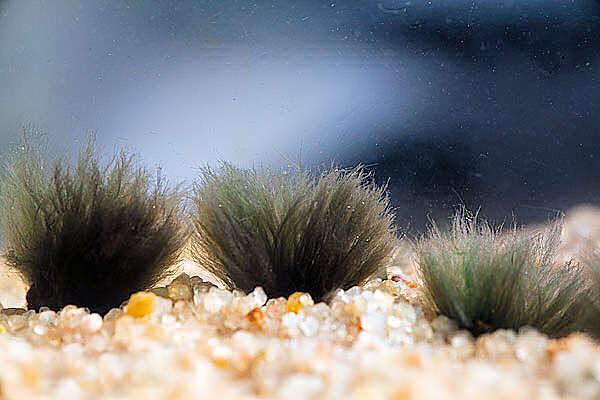
- The flip flop and black beard are very similar. But there are also differences:
- First, a Vietnamese woman is many times more tenacious than a beard. Even a month in complete darkness does not kill her. It is tough, strong and firmly attached to any surface.
- Secondly, no one eats it, except for 1-2 species of snails.
- Thirdly, the reason for the appearance. The flip-flop is usually brought in from other aquariums.
Diatoms
Or diatoms (lat. Diatomeae) are a large group of unicellular algae. Mostly unicellular, although there are also forms in the form of colonies. The main difference between diatoms is that they have a shell made of silicon dioxide. This view is very diverse, some are quite beautiful, but mostly look like two asymmetrical sides with a clear separation between them. Fossilized remains indicate that diatoms appeared in the early Jurassic period. More than 10,000 different species are now found.
In the aquarium, they look like brown algae, which cover all internal surfaces with a continuous film. Usually appear in a new aquarium or when there is a lack of light. You can get rid of them as well as brown ones, by increasing the number and length of daylight hours. Also worth applying internal filter with a charcoal filter for water purification from silicates. 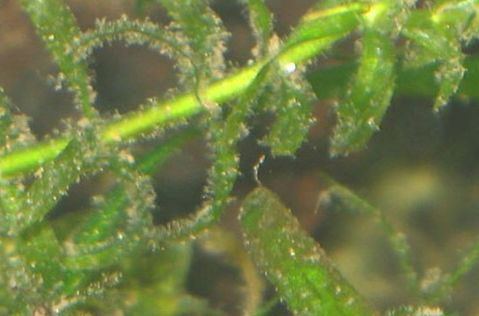
Blue-green algae in the aquarium
Blue-green algae are colonies of bacteria, and this is how they differ from other types of algae. They look like a green, slippery film covering the soil and plants in the aquarium. They rarely appear in the aquarium, and, as a rule, in those that are poorly looked after. Like all bacteria, they secrete substances that have a detrimental effect on plants and fish in the aquarium, so they must be carefully controlled. How to deal with blue-green algae in an aquarium?
As a rule, the antibiotic bicillin or other types of antibiotics are used in the fight, but you need to work very carefully with it, you can irreversibly affect all the inhabitants of the aquarium. It is best to try to balance the aquarium by doing a large water change and cleaning. 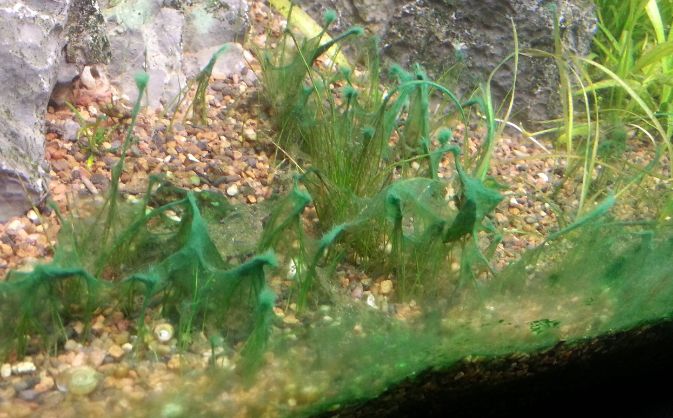
Green water in the aquarium or blooming water
Green water in an aquarium is obtained due to the rapid reproduction of a single-celled alga - green euglena. It manifests itself as a cloudy water to a completely green color. The water loses its transparency, the balance in the aquarium is disturbed, the fish suffer. As a rule, water bloom occurs in spring, with an increase in the amount of light, and water bloom in natural reservoirs from which we obtain water. To combat water bloom, you need to reduce the amount of lighting in the aquarium to a minimum, it is better not to light at all for a while. The most effective method is a UV lamp installed in an external filter.
Very effective method fight against water bloom - make a change and completely shade the aquarium for 3-4 days (for example, cover with a blanket). Plants will survive this. Fish too. But the water usually stops blooming. After that, make a substitution. 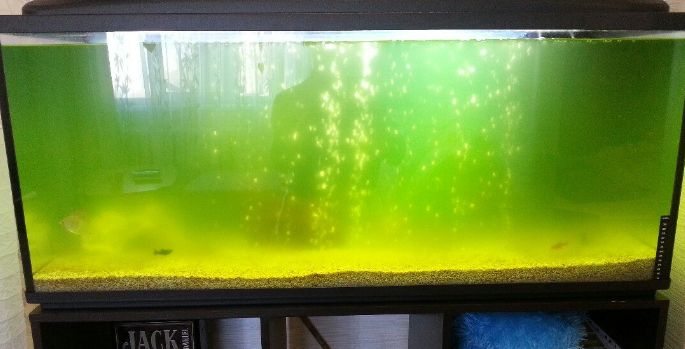
Thread
The filament in the aquarium consists of several types - edogonium, spirogyra, cladofora, rhizoclonium. All of them are united by their appearance - similar to a thin thread, green balls. It is filamentous green algae. How to deal with floss in an aquarium? An effective method of control is the use of algicides - agents that help fight algae in the aquarium, they can be purchased at pet stores. The simplest and most affordable method is manual removal. As a rule, the threads are quite fragile and easily detach from the surface. Also, some types of fiber are happy to eat shrimp, for example, it can easily cleanse even a large aquarium of thread.
Its appearance and growth depends on the nutrient content of the water. This is usually due to the fact that either too much fertilizer has been poured into the aquarium, or there is a substrate in the aquarium, it releases nutrients and there is no one to absorb them. In such cases, substitutions and fast-growing plants (nayas and elodea, hornwort) help 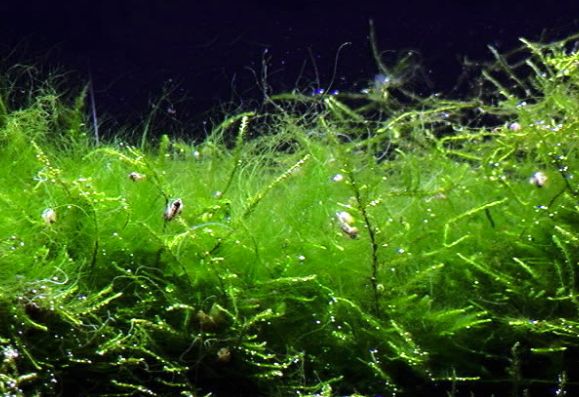
Why does algae grow in an aquarium
- An aquarium with a large number of aquarium plants, algae will still be in it, but they will not develop rapidly.
- Good aeration of the water - the increased oxygen content inhibits the growth of algae.
- Filtration and stirring of water to remove organic residues and nitrates
- Full lighting - no more than 12 hours a day, and with sufficient power.
- A moderate number of fish in the aquarium, with a large number, they create nitrates, which do not have time to be absorbed by plants.
- Fish that feed on algae - mollies, ancistrus, loricaria, SAE (Siamese algae eaters), ototsinklyus, girinoheilus.
- , rotting food debris is the main supplier of nitrates.
- Regular cleaning of the aquarium and replacement of some of the water.
Algae in the new aquarium
In only neglected aquariums the nitrogen cycle has not yet been established, and the probability of an algal outbreak is especially high in them.
The very fact that algae will appear in a new aquarium is normal. In the first 2-10 weeks after starting a new aquarium, you can see the rapid growth of brown algae. This happens if the nitrate level in the water exceeds 50 mg per liter. Filtration and partial water changes solve this problem.
As soon as the plants take root and grow, they will take food from the algae and the growth of the latter will slow down or stop. In an established aquarium, there is always a struggle for balance between plants and algae.
Fish that help fight algae in the aquarium:
- Kirill Vinogradov
Please tell me what to do.
got an aquarium of 120 liters, about six months no one came up, in the literal sense of the word. The water has evaporated by half, the fish…. no, a lot of thread, flip flops .. The question is - how to clean the jar itself, and whether to throw out the algae?Oleg
If you want an aquarium without flip flops, it is better to throw it out, use new water. Treat the jar itself with household chemicals, dry it. Although over time the algae will still get into the aquarium, it is more important to adjust the balance here.
Dried leaf kelp that completely regains its natural appearance after soaking. Natural marine product, saturated with polysaccharides, vitamins, iodine and other micro and macro elements. It is extremely effective in the course of weight loss procedures, in anti-cellulite and tonic programs. In a beauty salon, it can be used without rinsing. Frequency of procedures
Laminaria Japonica - has wide and long thalli and may contain some sand. It grows in the Sea of Okhotsk and the Sea of Japan. Before soaking, it is recommended to rinse the algae in running water using a brush or sponge, and then place it in a container of water for 20 minutes. After soaking on the surface of this type of algae, a dense jelly-like layer of marine polysaccharides does not form. Nevertheless, wraps with this type of algae give a pronounced anti-cellulite effect, have a drainage effect, and provide deep mineralization.
Laminaria Digitata - narrower thalli. The shape of the plate outwardly resembles a human hand. It grows in the northern seas (White, Barents, Kara). There may be small shells on the surface, there is no sand. The algae are perfectly clean, on the surface there is an abundant alginate layer, which is present in large quantities in the water where the kelp is soaked. Therefore, the resulting infusion can be used after straining for a number of cosmetic procedures.
Depending on the season, we offer either two types of algae, or only Laminaria Japonica, since the extraction of Laminaria Digitata in winter is difficult due to storms and severe weather conditions in the Russian North. The technology of drying the kelp thallus guarantees the complete preservation of all natural chemical compounds and vitamins from sea water, converted in the tissues of algae into organic compounds that are easily absorbed by the skin.
Compliance with this principle begins with the first stage of raw material preparation, where the traditional Pomor method of drying algae "on hangers" is used. This allows you to fully preserve the natural composition in "living algae", which at a moisture content of 17-22% do not lose their natural properties for three years.
The second stage (final drying of algae) is carried out in special devices, where infrared extraction of water from algae occurs in the temperature range from 35 to 45Cº. Such a drying process guarantees the preservation of all vitamins of group A, B1,2,5,6,12, C, D, E, organic compounds, trace elements and other natural substances from kelp in the raw materials.
LAMINARIA seaweed for wrapping, 1 kg, 3 kg, 5 kg
Benefits of the leaf algae wrap procedure
VISIBLE EFFECT after the first procedure due to the high content of ALGINATES in the algae
Low cost of the procedure
Can be used WITHOUT SHOWER
CONVENIENCE OF USE
Possibility of use in SPA-CAPSULE, INFRARED CABIN
Excellent compatibility with any anti-cellulite treatments and products
Complete NO CHEMICAL ADDITIVES
In a procedure aimed to achieve a cosmetic effect: weight loss, increased skin elasticity, improvement of figure contours, strengthening of flabby skin and cellulite reduction, you need to make normothermic wrapping(water temperature 60-70 С, soaking time - 20-30 minutes). The warmth helps to open the pores and penetrate the active substances from the algae into the skin. Soaking is carried out at the rate of 250/300 grams of raw materials for 1-1.5 liters of water. If the subsequent use of a concentrated solution is planned, the water must be purified. It should be borne in mind that after soaking, the algae significantly increase in volume (the rate of consumption for wrapping the whole body is 250/300 grams of dry algae).
1. For cold wrap (applied in medicinal purposes in accordance with the recommendations of the attending physician or in the presence of contraindications to normothermic wrapping, as well as to increase skin tone and mineralization), take the required amount of laminaria plates by area, place them in a container with water at room temperature (18-20C), leave to soak for 1 -1.5 hrs
2. When placed in water, the kelp thallus is covered with a thin jelly layer containing nutrients (alginic acids, hyaluronic acid, mannitol) and sea salt. It does not need to be removed before applying the algae to the body.
3. The soaked algae is applied to previously cleansed problem areas of the skin or the whole body, with the exception of the facial skin, like a compress with an exposure of 40-60 minutes... It is advisable to increase the time of the procedures gradually. Before wrapping, it is permissible to use a scrub, massage, steam the skin, as well as any procedures that help open the pores.
4. To enhance the impact, you should wrap the necessary areas film, cloth, thermal blanket (heating up to 45 C).
5. After removing the algae, take shower without soap or, using a sponge, sponge, disposable towel, wipe the skin with the remaining infusion from soaking without subsequent rinsing with water.
6. Thalassotherapy course - 6-12 sessions twice a week... The wraps do not have an immediate effect. After each session, it is worth measuring problem areas. A decrease in the volume of the thighs by 1-2.5 cm after the first procedure is due to the evaporated liquid, which will return after a while. But if you carry out wrapping courses every six months, the positive effect will be fixed for a long time.
7. Kelp leaf can be used inSPA-alfa capsule and infrared cabin.
8. Concentrated solution remaining after soaking the algae can, after having previously filtered, be used for washing, cleansing the skin of the face, general rubbing of the skin after a bath or sauna, for taking baths, soaking bandages for wraps... Frozen solution in the form ice cubes used for cryomassage, as a strong tonic for the skin of the face and body, especially the décolleté, very effective steam inhalation with kelp infusion, rinses oral cavity. A bath with kelp infusion is used for healing and rejuvenating the skin. To prepare a bath from kelp infusion, 1 liter of infusion is used. The optimum bath temperature is 37-40 C, the procedure time is 15-20 minutes, 2-3 times a week. Rubdown can be done as a standalone procedure or in combination with body wraps. When rubbing, rub the body well with infusion of kelp, wrap it in a sheet, the duration of the procedure is 30-40 minutes.
When wrapping with leaf kelp, when soaking algae into the air, it releases a large number of such biologically active substances as aerofitons. Aerofitons are volatile compounds found in large quantities in algae, also called "air vitamins". When inhaled, they affect the cardiovascular, central nervous system, normalize hormonal levels, increase immunity. Therefore, the wrapping session also turns into an Aromatherapy session.
Live algae of the White Sea.
Laminaria leaf for wrapping is one of the popular wrapping products for SPA procedures. Ingredients: whole thalli of the White Sea Laminaria algae (dried green-brown product with a characteristic white bloom of alginates and magnet). Soak before use.
Action: After soaking, dried kelp leaves come to life literally before our eyes, straightens, changes color, a real smell of the sea appears.
Kelp thallus are rich in iodine, mannitol, alginic acid salts, trace elements. Laminaria is one of the oldest algae, which has carefully accumulated all the wisdom of the world's oceans. This product is very valuable in the wrapping procedure. The product captivates with the aesthetics of the actual wrapping procedure itself and the guaranteed result, primarily due to the fact that dried whole algae in the thallus is the maximum of the properties of living algae.
Laminaria leaf wraps are very effective:
• for weight loss,
• fight against cellulite, stretch marks,
• to relieve swelling and detoxify the skin,
• enrichment of the skin with minerals and vitamins,
• moisturizing, nourishing the skin. The action is similar to the action of the powder from a mixture of algae for wrapping.
• relief of the course of varicose veins.
Application: Algae wrapping is carried out without any difficulty, since the leaves of some of them are very large in size (after preliminary soaking, they significantly increase in volume and stratify into thin plates).
After peeling and preliminary soaking in water (15-20 minutes at room temperature of water), the alga takes its original form, significantly increasing in size and covered with a thin layer of jelly, is applied to the skin.
Wrap with a film or thermal blanket, if there are no contraindications for its use, for 20-30 minutes. Then the algae is removed.
Rinsing is not required, which is especially important if there is no shower cabin in the master's office.
The course is 1-2 times a week, 10-12 procedures.
Method of home wrapping with dried kelp seaweed:
During the procedure aimed at achieving a cosmetic effect: weight loss, increased skin elasticity, improvement of figure contours, strengthening of flabby skin and reduction of cellulite, it is necessary to perform normothermal wrapping (water temperature 60-70 C, soaking time - 20-30 minutes).
The warmth helps to open the pores and penetrate the active substances from the algae into the skin. Soaking is carried out at the rate of 250/300 grams of raw materials for 1-1.5 liters of water. If the subsequent use of a concentrated solution is planned, the water must be purified. It should be borne in mind that after soaking the algae significantly increase in volume.
1. For cold wrapping (used for medicinal purposes in accordance with the recommendations of the attending physician or in the presence of contraindications to normothermal wrapping, as well as to increase skin tone and mineralization), take the required amount of kelp plates by area, place them in a container with water at room temperature ( 18-20C), leave to soak for 1-1.5 hours.
2. When placed in water, the kelp thallus is covered with a thin jelly layer containing nutrients (alginic acids, hyaluronic acid, mannitol) and sea salt. It does not need to be removed before applying the algae to the body.
3. The soaked algae is applied to previously cleansed problem areas of the skin or to the whole body, except for the skin of the face, by the type of a compress with an exposure of 40-60 minutes. It is advisable to increase the time of the procedures gradually. Before wrapping, it is permissible to use a scrub, massage, steam the skin, as well as any procedures that help open the pores.
4. To enhance the impact, wrap the necessary areas with a film, cloth, blanket.
5. After removing the algae, take a shower without using soap or, using a sponge, sponge, disposable towel, wipe the skin with the remaining infusion from soaking without subsequent rinsing with water.
6. Thalassotherapy course - 6-12 sessions twice a week. The same kelp plate can be reused (in this case, it is placed in the infusion and stored at room temperature for up to 5 days), but no more than 3 times and strictly individually.
7. The concentrated solution left after soaking the seaweed can, after being filtered, be used for washing, cleansing the skin of the face, general rubbing of the skin after a bath or sauna, for taking baths, soaking bandages for wrapping. The frozen solution in the form of ice cubes is used for cryomassage, as a strong tonic for the skin of the face and body, especially the décolleté, steam inhalations with infusion of kelp, rinsing the mouth are very effective. A bath with kelp infusion is used for healing and rejuvenating the skin. To prepare a bath from kelp infusion, 1 liter of infusion is used. The optimum bath temperature is 37-40 C, the procedure time is 15-20 minutes, 2-3 times a week. Rubdown can be done as a standalone procedure or in combination with body wraps. When rubbing, rub the body well with kelp infusion, wrap it in a sheet, the duration of the procedure is 30-40 minutes.
Contraindications to seaweed wrapping: Hyperfunction thyroid gland, individual intolerance to iodine and seafood, open wounds or inflammatory skin diseases, postoperative stitches, pregnancy.
ADVANTAGES OF LEAF (LIVE) ALGAE WRAPPING PROCEDURE. -the visible effect of the procedures due to the high content of biologically active substances (iodine, alginates, vitamins, minerals and macronutrients)
-low cost of the procedure
-can be used WITHOUT SHOWER CABIN
-convenient and quick application and removal of leaf algae
-possibility of application in SPA-CAPSULE, INFRARED CABIN
-excellent compatibility with any anti-cellulite procedures
-complete NO CHEMICAL ADDITIVES
If you have never had a herbalist (aquarium with live plants) and have never observed one, you might be surprised how lively and vibrant an aquarium can look. This is because the plants provide the aquarium with natural filtration, and they help the fish stay healthy and even breed. Aquarium plants provide safety, comfort, nutrition and reproduction to fish, which is why they are so important for creating a healthy environment.
Below is a list of 10 plants that are nearly impossible to kill and that grow quickly in almost any water setting. These are the best aquarium plants for the beginner hobbyist.
Before the fish is launched into the aquarium, it must go through what is called a cyclical process, during which the parameters and water quality change. While these processes are going on, some species of fish cannot survive them, so as much as you would like to do this, you should not put the fish into the aquarium on the very first day. Experienced aquarists strongly advise not to put fish in the aquarium right away, but wait a few days.
But all this does not apply to aquarium plants! Plants can be planted in the aquarium as soon as you fill it with water.
Carpet plants or ground cover plants such as Java moss, Willow moss and hygrophila tend to stay close to the ground and spread over the entire bottom of the aquarium. Therefore, they are called foreground plants. These plants usually grow quite quickly, so they filter a fairly large amount of water, which means they improve its quality.
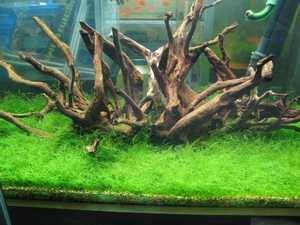
Java moss is one of the most common plants in the aquarium. The plant is unpretentious, does not require special care, grows quickly and rarely dies - what a novice aquascaper needs. When tied to a rock, it will grow over the entire surface of your tank. This moss can float on the surface, so be sure to attach it to something so that it doesn't float far.
Appearance: undersized plant, type "fluffy".
Water parameters: 22-32 degrees Celsius. It grows most rapidly at 22-23 degrees.
Lighting: grows in any light, but grows most intensively in medium to bright light.
Application: decorating, covering the bottom, creating a carpet, protecting and breeding some species of fish.
Cryptocoryne
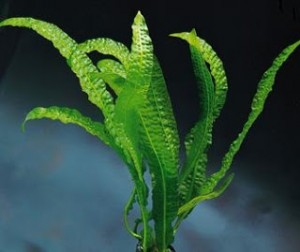
Cryptocorynes are a very common aquarium plant and one of the most unpretentious hobbies in the aquarium. They adapt to the widest range of water parameters, perfectly tolerate hard water and can exist in soft water. Cryptocorynes on sale are found different types, there are some truly beautiful specimens suitable for both large and small / nano aquariums. It grows in both low and strong light.
Appearance: a wide variety of species, varying in size, leaf shape and color, from brown to green.
Water parameters: 18-30 degrees Celsius.
Lighting:
Application: depending on the type and size of the aquarium, it is used for the foreground, middle ground and background.
Needle synthag (Eleocharis acicularis)
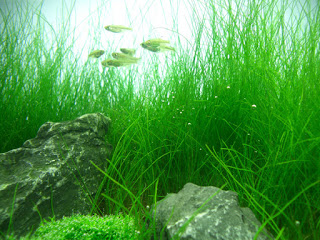
With this plant, the possibilities for aqua design are almost endless. Syntag looks great against the background of stones, and also goes well with dark soil or sand. The needle synthag reproduces incredibly quickly and easily, so easily that having planted a small island, you will very soon realize that your aquarium already needs weeding. Aquarists jokingly call this plant an aquarium weed, for its vitality and indestructibility.
Appearance: the plant looks like grass, with small strands of grass. Easily forms a carpet in most aquatic environments.
Water parameters:
Lighting: grows best in very bright light.
Application: an ornamental plant that goes best with stone and wood, emphasizing their beauty. Forms a carpet.
Marsilia (Marsilea quadrifolia)
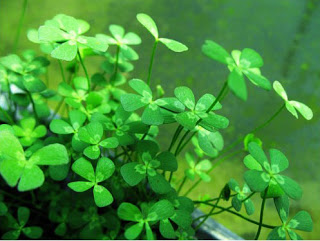
It is easy to create any aqua design with this plant. As well as synthetics, Marsilia looks great against the background of stones and snags, and also looks great on dark ground. It grows very quickly and by planting quite a bit of Marsilia, you will soon get a gorgeous carpet.
Appearance: it is very easy to distinguish from other plants by the shape of the leaves, similar to those of clover leaves. Easily forms a carpet in most aquatic environments.
Water parameters: withstands any water parameters. It grows most rapidly at 22-23 degrees.
Lighting: grows best in medium light.
Application: a decoration that works best with stone and wood, highlighting their beauty. Carpets and protects fish, fry and shrimp.
Echinodorus amazonicus (Echinodorus amazonicus)
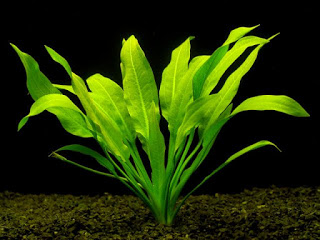
It is very often used in the design of aquariums. It is easy to care for, Echinodorus grows very quickly and very beautifully. It can be very effective if planted successfully in the right place. This plant can reach a height of up to 20 cm, so it is better to plant it in the middle of the aquarium or in the background.
Appearance: large pointed leaves.
Water parameters: grows best at 22-28 degrees Celsius.
Lighting:
Application: background design, decoration of equipment (filters, heaters, etc.).
Thai fern (Microsorum pteropus)
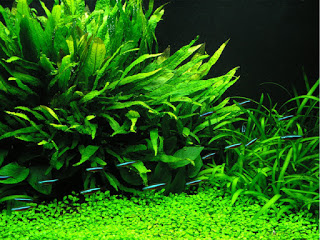
A low, very unpretentious plant, with very slow growth (like all ferns). This plant has no analogues in appearance and fits any design. It can be planted anywhere in the aquarium - it will look good anywhere.
Appearance: semi-striped wide leaves growing in a bunch.
Water parameters:
Lighting: grows fastest in low to medium light.
Application: decoration.
Anubias nana
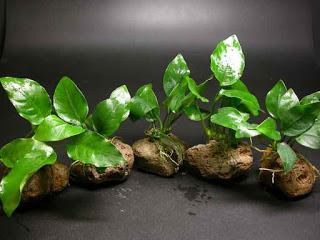
Anubias is one of the most attractive mid-range plants. It tolerates almost any parameters and water quality quite well. Its round, curved leaves look great against a stone backdrop, which is why anubias is almost always present in Iwagumi aqua design. It grows very slowly, which can be a plus in aqua design - it does not require frequent haircuts. In general, all anubias look like decorative artificial flowers, apparently because of their hard leaves.
Appearance: a curved stem creeping along the ground; and semi-round curved leaves.
Water parameters: It grows best at 22-25 degrees Celsius.
Lighting: grows best in medium light.
Application: decoration, will look great anywhere in the aquarium.
Echinodorus tender (Echinodorus tenellus)
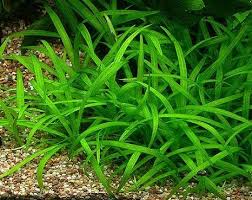
This plant is rarely found in aqua design just because appearance it resembles ordinary grass on the lawn, which we see every day. However, it is quite possible to use it in design, and if you place the delicate Echinodorus correctly, it will look very good. This plant does not form a carpet, but can grow quite densely. It is very bright, often dazzling green, and quite attractive. And it's almost impossible to kill him.
Appearance: its appearance strikingly resembles lawn grass.
Water parameters: Grows best at 22-25 degrees Celsius.
Lighting: grows best in medium to bright light.
Application: decoration, will look good around stones.
Hydrocotyle Griffon (Hydrocotyle leucocephala)
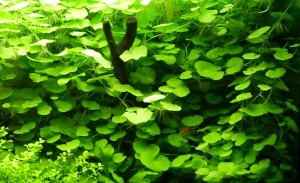
White-headed hydrocotyl is a plant with an unusual round shape of leaves the size of a coin, a light green color, very attractive and practically unkillable. Hydrocotyl white-headed extremely hardy aquarium plant, the best choice for beginners. Grows well in low light, grows very quickly in strong light. Water tolerates both soft and hard, and also wide range temperatures. Under favorable conditions, regular pruning will be needed.
Appearance: round green leaves along a long stem.
Water parameters: grows best at 22-25 degrees Celsius.
Lighting: grows in both low and strong light; with strong growth, rapid.
Application: suitable for both background and foreground.
Arrowhead subulate (Sagittaria subulata)
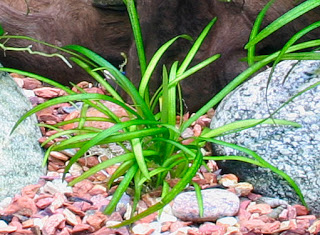
A medium-sized plant, the growth reaches a maximum of 8-12 cm. It is best to plant an arrowhead around stones and driftwood, it will be an excellent addition to them.
Appearance: bright, green, curled leaves.
Water parameters: grows best at 22-25 degrees Celsius.
Lighting: fastest growing in medium light.
Application: decoration, will look good around stones, snags.





